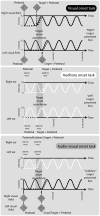Multisensory perceptual learning of temporal order: audiovisual learning transfers to vision but not audition
- PMID: 20585664
- PMCID: PMC2890588
- DOI: 10.1371/journal.pone.0011283
Multisensory perceptual learning of temporal order: audiovisual learning transfers to vision but not audition
Abstract
Background: An outstanding question in sensory neuroscience is whether the perceived timing of events is mediated by a central supra-modal timing mechanism, or multiple modality-specific systems. We use a perceptual learning paradigm to address this question.
Methodology/principal findings: Three groups were trained daily for 10 sessions on an auditory, a visual or a combined audiovisual temporal order judgment (TOJ). Groups were pre-tested on a range TOJ tasks within and between their group modality prior to learning so that transfer of any learning from the trained task could be measured by post-testing other tasks. Robust TOJ learning (reduced temporal order discrimination thresholds) occurred for all groups, although auditory learning (dichotic 500/2000 Hz tones) was slightly weaker than visual learning (lateralised grating patches). Crossmodal TOJs also displayed robust learning. Post-testing revealed that improvements in temporal resolution acquired during visual learning transferred within modality to other retinotopic locations and orientations, but not to auditory or crossmodal tasks. Auditory learning did not transfer to visual or crossmodal tasks, and neither did it transfer within audition to another frequency pair. In an interesting asymmetry, crossmodal learning transferred to all visual tasks but not to auditory tasks. Finally, in all conditions, learning to make TOJs for stimulus onsets did not transfer at all to discriminating temporal offsets. These data present a complex picture of timing processes.
Conclusions/significance: The lack of transfer between unimodal groups indicates no central supramodal timing process for this task; however, the audiovisual-to-visual transfer cannot be explained without some form of sensory interaction. We propose that auditory learning occurred in frequency-tuned processes in the periphery, precluding interactions with more central visual and audiovisual timing processes. Functionally the patterns of featural transfer suggest that perceptual learning of temporal order may be optimised to object-centered rather than viewer-centered constraints.
Conflict of interest statement
Figures



References
-
- Mauk MD, Buonomano DV. The neural basis of temporal processing. Annu Rev Neurosci. 2004;27:307–340. - PubMed
-
- Michon JA. The complete time experiencer. In: Michon JA, Jackson JL, editors. Time, Mind and Behavior. Berlin: Springer-Verlag; 1985. pp. 21–52.
-
- Edwards CJ, Alder TB, Rose GJ. Auditory midbrain neurons that count. Nat Neurosci. 2002;5:934–936. - PubMed
-
- Schirmer A. Timing speech: a review of lesion and neuroimaging findings. Brain Res Cogn Brain Res. 2004;21:269–287. - PubMed
-
- Alais D, Newell FN, Mamassian P. Multisensory processing in review: from physiology to behaviour. Seeing Perceiving. 2010;23:3–38. - PubMed
MeSH terms
LinkOut - more resources
Full Text Sources

